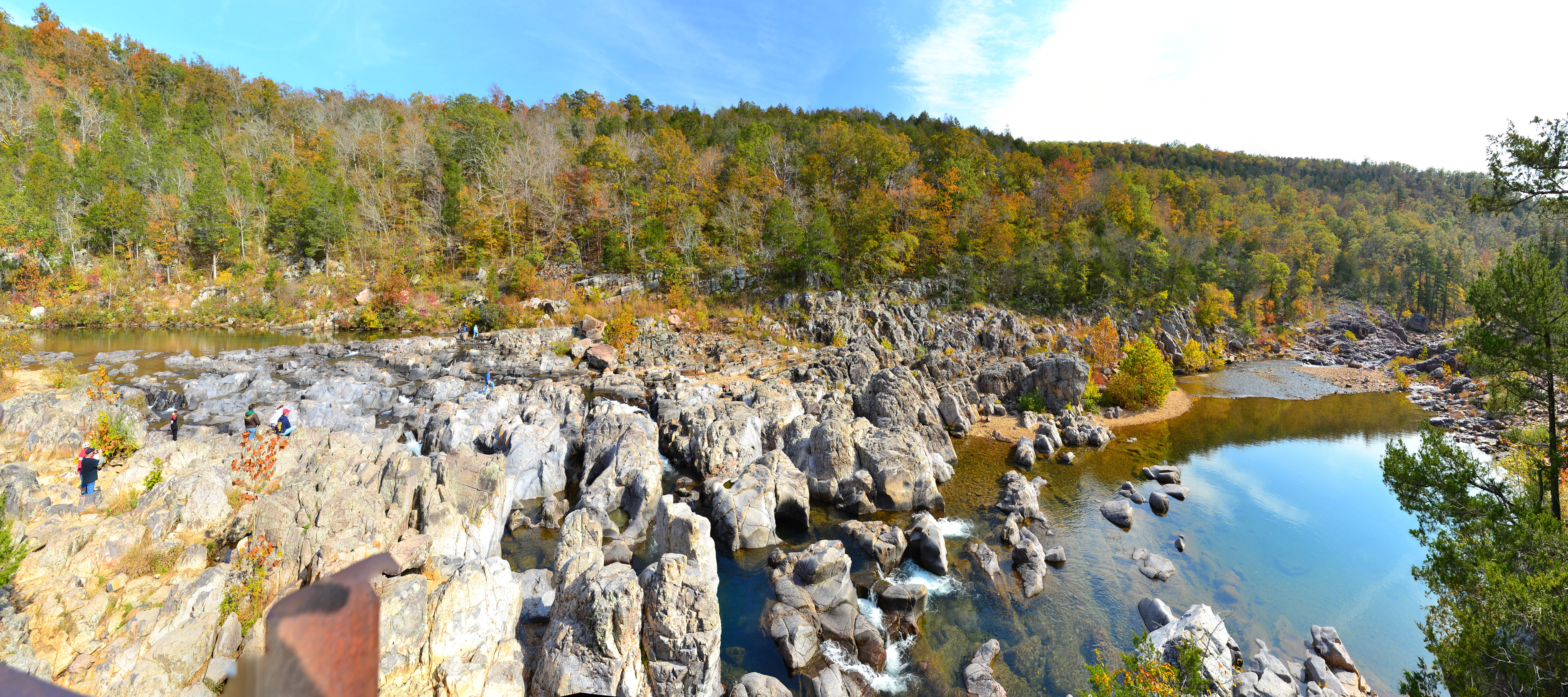Shut-in (river) on:
[Wikipedia]
[Google]
[Amazon]
 A shut-in is a type of
A shut-in is a type of
 A shut-in is a type of
A shut-in is a type of rock formation
A rock formation is an isolated, scenic, or spectacular surface rock outcrop. Rock formations are usually the result of weathering and erosion sculpting the existing rock. The term ''rock formation'' can also refer to specific sedime ...
found in streams in the Ozarks
The Ozarks, also known as the Ozark Mountains, Ozark Highlands or Ozark Plateau, is a physiographic region in the U.S. states of Missouri, Arkansas, Oklahoma and the extreme southeastern corner of Kansas. The Ozarks cover a significant por ...
, comprising pools, rivulet
A stream is a continuous body of surface water flowing within the bed and banks of a channel. Depending on its location or certain characteristics, a stream may be referred to by a variety of local or regional names. Long large streams a ...
s, rapids
Rapids are sections of a river where the river bed has a relatively steep gradient, causing an increase in water velocity and turbulence.
Rapids are hydrological features between a ''run'' (a smoothly flowing part of a stream) and a ''cascade' ...
and plunge pool
A plunge pool (or plunge basin or waterfall lake) is a deep depression in a stream bed at the base of a waterfall or shut-in. It is created by the erosional forces of cascading water on the rocks at formation's base where the water impacts.Marsh ...
s. The term has an origin in Appalachia
Appalachia () is a cultural region in the Eastern United States that stretches from the Southern Tier of New York State to northern Alabama and Georgia. While the Appalachian Mountains stretch from Belle Isle in Newfoundland and Labrador, ...
.
Description
A shut-in is a rock formation that carve through a mountain ranges, causing a complex of pools, rivulets, rapids and plunge pools. They are found in streams in the Ozarks. Shut-ins are inherently confined to a narrowvalley
A valley is an elongated low area often running between hills or mountains, which will typically contain a river or stream running from one end to the other. Most valleys are formed by erosion of the land surface by rivers or streams over ...
or canyon
A canyon (from ; archaic British English spelling: ''cañon''), or gorge, is a deep cleft between escarpments or cliffs resulting from weathering and the erosive activity of a river over geologic time scales. Rivers have a natural tendency to cut ...
, with the river valley widening out both above and below the formation. Because the rock resists downcutting
Downcutting, also called erosional downcutting, downward erosion or vertical erosion is a geological process by hydraulic action that deepens the channel of a stream or valley by removing material from the stream's bed or the valley's floor. ...
, streams typically descend at relatively steep gradient through shut-ins, with the downstream terminus of the formation often marked by a very large plunge pool. The river becomes unnavigable at shut-ins even by canoe due to the rapids and narrow channels.
Etymology
The term has an origin in Appalachia, where it was used to refer to a narrow rivergorge
A canyon (from ; archaic British English spelling: ''cañon''), or gorge, is a deep cleft between escarpments or cliffs resulting from weathering and the erosive activity of a river over geologic time scales. Rivers have a natural tendency to c ...
confined by resistant rock layers.
Examples
Johnson's Shut-Ins State Park in Missouri, with its hardrhyolite
Rhyolite ( ) is the most silica-rich of volcanic rocks. It is generally glassy or fine-grained ( aphanitic) in texture, but may be porphyritic, containing larger mineral crystals ( phenocrysts) in an otherwise fine-grained groundmass. The min ...
and a diabase
Diabase (), also called dolerite () or microgabbro,
is a mafic, holocrystalline, subvolcanic rock equivalent to volcanic basalt or plutonic gabbro. Diabase dikes and sills are typically shallow intrusive bodies and often exhibit fine-gra ...
dike
Dyke (UK) or dike (US) may refer to:
General uses
* Dyke (slang), a slang word meaning "lesbian"
* Dike (geology), a subvertical sheet-like intrusion of magma or sediment
* Dike (mythology), ''Dikē'', the Greek goddess of moral justice
* Dikes, ...
that divert the Black River into many small streamlets following a complex joint system, is the most well known example.Beveridge, T. R., ''Geologic Wonders and Curiosities of Missouri,'' Missouri Department of Natural Resources, 2nd ed. 1990, p. 39–62 More than ninety other shut–ins occur within and around the St. Francois Mountains
The St. Francois Mountains in southeast Missouri are a mountain range of Precambrian igneous mountains rising over the Ozark Plateau. This range is one of the oldest exposures of igneous rock in North America.
The name of the range is spelled out ...
region of southeast Missouri. In southern Illinois, the Burden Falls Wilderness
The Burden Falls Wilderness is a 3,775-acre (15.3 km2) unit of the Shawnee National Forest. It is located in northwestern Pope County and southwestern Saline County, Illinois. The wilderness is characterized by road-less second-growth har ...
area includes a narrow canyon below a waterfall that is confined by a resistant sandstone
Sandstone is a clastic sedimentary rock composed mainly of sand-sized (0.0625 to 2 mm) silicate grains. Sandstones comprise about 20–25% of all sedimentary rocks.
Most sandstone is composed of quartz or feldspar (both silicates ...
layer; the gorge is referred to as a ''shut–in'', following the Appalachian usage for the term.
See also
*References
Rivers Ozarks {{Geo-term-stub